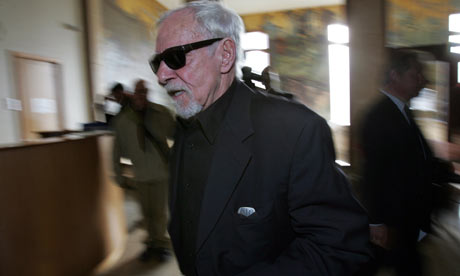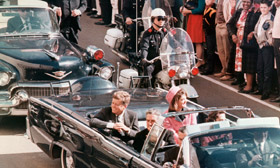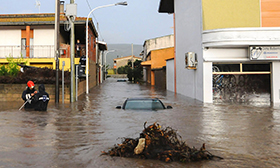On a narrow street behind Marseille's old port, where hostess bars nudge up against sandwich shops, Christine Imbert was redecorating her beauty salon, Starlet's. Business isn't easy when you're known as Marseille's foremost gangster's moll.
"People judge you for your name," sighed the 38-year-old, proud to be the fourth wife of Jacky "Le Mat" Imbert, 79, one of the most notorious godfathers of the French criminal underworld.
Mrs Imbert has branched out from her routine waxing and sunbeds with a fashion line of T-shirts, jeans, snakeskin trousers and leather fedoras. Each carries the logo of a cat - the exact scribbled feline drawing her husband used to sign his name on his letters from prison.
Known as the Madman or the cat with nine lives, Jacky Imbert was once shot 23 times by hitmen but escaped. Despite the mix of drugs, gambling and prostitution that has dominated the Marseille mob scene for four decades, Imbert has sidestepped any serious convictions, serving only short prison terms. "The cops always came to ask me about the jobs I didn't do. For the ones I did do, I never saw anyone," he once said. He has no bodyguards and drinks in bars with his back to the door. Who would kill a man who came back from the dead?
"My husband is a true gentleman," said Mrs Imbert, admiring the framed pictures of Jacky with his friend, the actor Alain Delon. Her designer hooded sweatshirts bearing the prison number of the "Legend of Marseille" is a way of honouring him. She feels that modern-day Marseille criminals are out of control and have lost all sense of respect.
In Marseille's long history of organised crime, where murderous mobsters with names such as The Belgian and The Blond became folklore, it's perhaps not surprising that the underworld spawned its own spin-off clothing line.
But France's second city is now battling a new wave of murderous, organised crime gangs. The Mediterranean port city, designated European capital of culture for 2013, has for years worked to shed its gangland image as "Chicago of the south" and rebrand itself as a major city break destination. President Nicolas Sarkozy is pouring money into two new museums and wants the city to be the centre of his Mediterranean Union.
Cosmopolitan Marseille is fiercely proud that its housing estates did not erupt in the violent rioting of the Paris suburbs in 2005. Many felt it was because youth are fiercely proud of their Marseillais identity in a city that is not split into the ghettoes of racism of the Paris outskirts. But despite Marseille's ongoing transformation, its poor are struggling to stay afloat and gun-toting criminals are back in the headlines.
Three young men were shot dead in a car waiting at traffic lights in northern Marseille two weeks ago. It was the biggest single death toll of a series of murders over drug feuds and turf wars. "Marseille has always had organised crime, but in the past month we've seen an acceleration, a much greater density of attacks and murders," said Jacques Dallest, the state prosecutor. He listed 70 gun attacks this year. The number of armed hold-ups of boulangeries, small grocers and tobacconists in Marseille is rising so fast that the government has stepped in with special measures.
Across France, from Grenoble to Ajaccio, the number of feud murders by hitmen rose from 58 in 2007 to more than 120 last year. But Dallest said criminal execution-style killings remained Marseille's "regrettable speciality". On Tuesday night , "La Brise de Mer", the Corsican gang that has dominated the Marseille crime scene, saw one of its biggest godfathers murdered by a sniper. He was the second major godfather killed in Corsica in less than a month.
On Marseille's northern housing estates, social workers say poverty has worsened the problem. More than 20% of the city's population live below the poverty line. Although Marseille has recovered from the 1990s horror years of industrial decline and acute unemployment, joblessness still exceeds the national average. Local politicians warn that some estates have more than 40% youth unemployment and there is an "underground economy" of drug deals and turf wars.
When Fadéla Amara, the minister responsible for overhauling France's estates, visited Marseille's high rises last week, she was assailed by residents complaining about run-down housing and the lack of hope for the young.
"Where there is poverty and no prospects for young people, crime seems like an option, a way to climb the social ladder, and Marseille has always been a good university of crime," said the Marseille thriller writer Xavier-Marie Bonnot, who has made several films about the city's underworld.
Drugs have long been central to gang crime in a city that boasts the biggest port in the western Mediterranean. After the second world war, Marseille gangs known as the "French Connection" ran vast illegal laboratories processing heroin coming in from Turkey and the east. By the late 60s, about 80% of heroin in the US was trafficked from Marseille. In 1971, the figure of the Marseille drug baron was immortalised in the Hollywood film the French Connection, and for a decade, the city's criminal gangs killed each other in vicious feuding.
A drug trafficking trial last month showed that although Marseille is no longer a heroin or drug processing capital, it remains at the centre of the trade in cannabis coming into Europe through Spain from Morocco. The city is also a key point in the cocaine smuggling route into Europe from South America through west Africa. Local police have warned that members of the new generation of criminals are ready to use automatic weapons over the slightest drug trafficking rivalry.
In her salon, Mrs Imbert sighed: "Back then, in the 1970s, there was respect. Now people here seem to kill for nothing."
Old underworld
Jacques Imbert, 79, alias Jacky Le Mat, the Tomcat or Madman
Former champion trotting driver, aviator and nightclub supremo suspected by police of being a contract killer in the 1960s before becoming a key figure in Marseille's underworld in the 1970s. He was jailed in 2004 for a contraband cigarette scam involving the Russian mafia, but was later cleared on appeal. Describes himself as "retired".
Francis Vanverberghe, alias the Belgian
Notorious in the bloody battle for control of Marseille's "French connection" drug imports. Gunned down outside a betting shop on the Champs Elysée in Paris in 2000, near a bar where he was suspected of pimping, leaving behind a network bent on revenge.
Farid Berrhama, alias the Gremlin, Grey or the Roaster
A Marseille drugs kingpin suspected of at least a dozen gangland murders. He was shot down alongside a suspected henchman when a dozen armed men opened fire in a Marseille restaurant in 2006.
Christian Oraison, alias the Big Blond
Shot dead in August last year by hitmen in the village of Manosque, Provence. Suspected of numerous hold-ups of armed security vans transporting cash. A former associate of the Belgian.



















